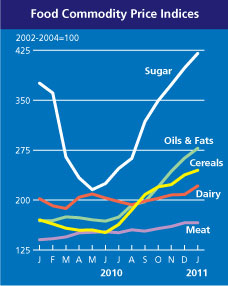 Serving both developed and developing countries, the Food and Agriculture Organization of the United Nations (FAO) is a specialized agency of the United Nations that leads international efforts to defeat hunger. The FAO has tracked food prices since 1990. As prices continue to rise on most of the indexes, we are approaching or exceeding the food prices that triggered riots in 2008.
Serving both developed and developing countries, the Food and Agriculture Organization of the United Nations (FAO) is a specialized agency of the United Nations that leads international efforts to defeat hunger. The FAO has tracked food prices since 1990. As prices continue to rise on most of the indexes, we are approaching or exceeding the food prices that triggered riots in 2008.
(Read more here: Casino of Hunger – Wall Street Speculators and the 2008 Food Crisis and here: Will we see food riots this year? Increasing prices, higher oil costs, decreasing supplies, growing populations – a perfect storm.)
The FAO Food Price Index (FFPI) rose for the seventh consecutive month, averaging 231 points in January 2011, up 3.4 percent from December 2010 and the highest (in both real and nominal terms) since the index has been backtracked in 1990.
Prices of all the commodity groups monitored registered strong gains in January compared to December, except for meat, which remained unchanged. Changes in the composition of the meat price index (read more) have resulted in adjustments to the historical values of the FFPI. One implication of this revision is that the December value of the FFPI, which previously was the highest on record, is now the highest since July 2008.
- The FAO Cereal Price Index averaged 245 points in January, up 3 percent from December and the highest since July 2008, but still 11 percent below its peak in April 2008. The increase in January mostly reflected continuing increases in international prices of wheat and maize, amid tightening supplies, while rice prices fell slightly, as the timing coincides with the harvesting of main crops in major exporting countries.
- The FAO Oils/Fats Price Index rose by 5.6 percent to 278 points, nearing the June 2008 record level, reflecting an increasingly tight supply and demand balance across the oilseeds complex.
- The FAO Dairy Price Index averaged 221 points in January, up 6.2 percent from December, but still 17 percent below its peak in November 2007. A firm global demand for dairy products, against the backdrop of a (normal) seasonal decline of production in the southern hemisphere, continued to underpin dairy prices.
- The FAO Sugar Price Index averaged 420 points in January, up 5.4 percent from December. International sugar prices remain high, driven by tight global supplies.
The FAO Meat Price Index has been revised to better reflect the structure of world trade in meat products. Changes were made to the price indices of the three main meat categories, namely bovine, poultry and pig meat, while the ovine meat index remained unaltered.
- The FAO Meat Price Index was steady at around 166 points, as falling prices in Europe, caused by a fall in consumer confidence following a feed contamination, was compensated by a slight increase in export prices from Brazil and the United States.
- The Bovine Meat Price Index showed that beef prices in January 2011 had surpassed the record reached in September 2008.
- The Pig Meat Price Index showed a pronounced surge in mid-2008 and, subsequently, a sharper fall during the financial crisis. Pig prices in January 2011 still fall short of the peaks reached during the 2007/08 soaring food price episode.
- The Poultry Meat Price Index shows that, despite a strong rise in late 2010, poultry prices in January 2011 are still below the late 2008 record.
Go to Global Information and Warning System on Food and Agriculture, for details on the world food situation.
